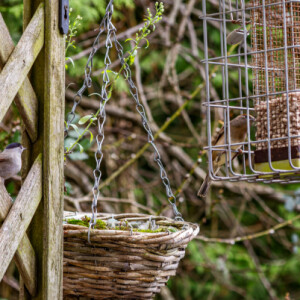A male blackcap eyeing up the suet pellets
I’ve been enjoying the plethora of birds that have been visiting the garden recently. I decided to clean the bird feeders as I’m concerned about avian flu amongst other infections that can affect them, especially when the many varied species congregate so quickly at the feeders.
Earlier I had looked down from my study window on the floor directly above here, as I can see a wider view of the garden and both feeders at once. I saw a mass of blue and great tits all flying back and forth around the sunflower feeder, and stopped counting at twenty birds at any one time, often with four or five on the feeder at once. One of the pair of woodpeckers, which are now regular feeders there, arrived shooing most of the other birds onto nearby branches to wait their turn.
I also noticed that a pair of bullfinches were in the tree behind the suet feeder, which they can’t actually use, because the beaks of finches are too large for the wire cage holding the pellets. It has reminded me to bring out an occasional suspended tray where they can land and eat the suet, en plain air, so to speak. But unfortunately all the big birds and squirrels can also get them, so I have to restrict the usage. These feeders are definitely squirrel proof, and I highly recommend them because of that.
I decided to spend some time sitting at the dining room table with my camera on a monopod to wait for visitors to this suet feeder hanging just outside the back door leading onto the steps down to the lower patio. As it wasn’t too cold today I even managed to keep the sliding doors open to avoid the distortion through the double-glazing.
The birds were definitely more reluctant to come to the feeder with the doors open, but gradually their hunger for the feed overcame their fears. Many tits and a nuthatch came and went, whilst a pair of bullfinches sat quietly on the branches in the background. A male blackcap perched near the trunk of the tree, a pussy willow.
Suddenly I saw the male land on the trellis, and within seconds the female, which is always much more timid, landed on the feeder and started to tuck in. Something startled them and they both flew rapidly away back into the branches behind.
The male reappeared within a few minutes landing on the hanging basket. It was only there for a few seconds as it caught sight of me, turned and then took off. I liked this action shot as it shows its feathers well. I’ve added the earlier shot of the pair of blackcaps as an ‘Extra’ to let you see the female although it is rather hidden, as usual.


Comments
Sign in or get an account to comment.


